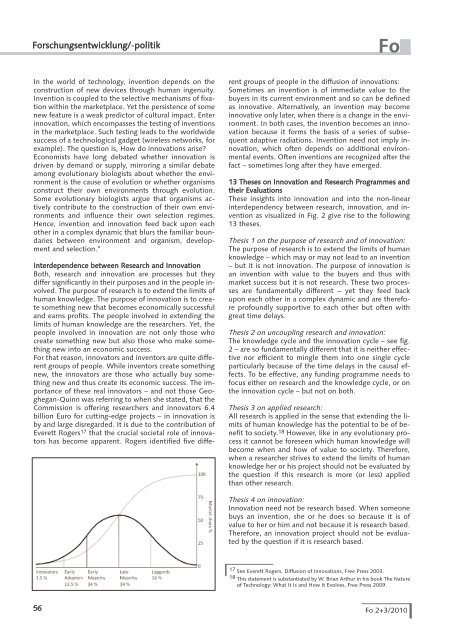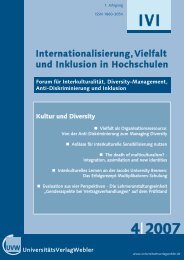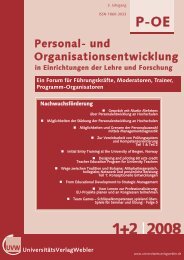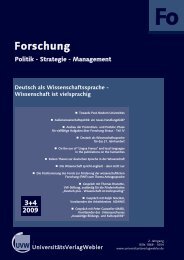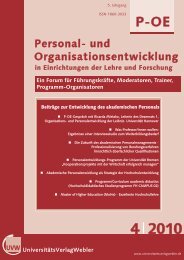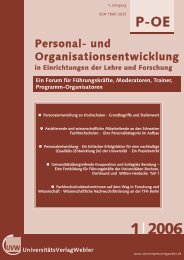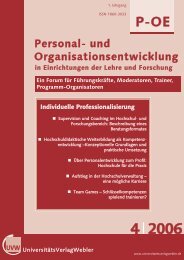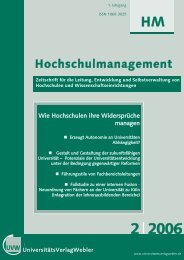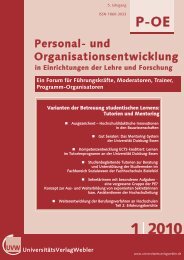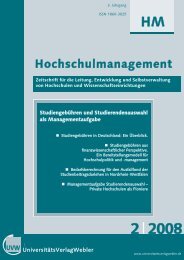Fo - UniversitätsVerlagWebler
Fo - UniversitätsVerlagWebler
Fo - UniversitätsVerlagWebler
Erfolgreiche ePaper selbst erstellen
Machen Sie aus Ihren PDF Publikationen ein blätterbares Flipbook mit unserer einzigartigen Google optimierten e-Paper Software.
<strong>Fo</strong>rschungsentwicklung/-politik<br />
<strong>Fo</strong><br />
In the world of technology, invention depends on the<br />
construction of new devices through human ingenuity.<br />
Invention is coupled to the selective mechanisms of fixation<br />
within the marketplace. Yet the persistence of some<br />
new feature is a weak predictor of cultural impact. Enter<br />
innovation, which encompasses the testing of inventions<br />
in the marketplace. Such testing leads to the worldwide<br />
success of a technological gadget (wireless networks, for<br />
example). The question is, How do innovations arise?<br />
Economists have long debated whether innovation is<br />
driven by demand or supply, mirroring a similar debate<br />
among evolutionary biologists about whether the environment<br />
is the cause of evolution or whether organisms<br />
construct their own environments through evolution.<br />
Some evolutionary biologists argue that organisms actively<br />
contribute to the construction of their own environments<br />
and influence their own selection regimes.<br />
Hence, invention and innovation feed back upon each<br />
other in a complex dynamic that blurs the familiar boundaries<br />
between environment and organism, development<br />
and selection.”<br />
Interdependence between Research and Innovation<br />
Both, research and innovation are processes but they<br />
differ significantly in their purposes and in the people involved.<br />
The purpose of research is to extend the limits of<br />
human knowledge. The purpose of innovation is to create<br />
something new that becomes economically successful<br />
and earns profits. The people involved in extending the<br />
limits of human knowledge are the researchers. Yet, the<br />
people involved in innovation are not only those who<br />
create something new but also those who make something<br />
new into an economic success.<br />
<strong>Fo</strong>r that reason, innovators and inventors are quite different<br />
groups of people. While inventors create something<br />
new, the innovators are those who actually buy something<br />
new and thus create its economic success. The importance<br />
of these real innovators – and not those Geoghegan-Quinn<br />
was referring to when she stated, that the<br />
Commission is offering researchers and innovators 6.4<br />
billion Euro for cutting-edge projects – in innovation is<br />
by and large disregarded. It is due to the contribution of<br />
Everett Rogers 17 that the crucial societal role of innovators<br />
has become apparent. Rogers identified five different<br />
groups of people in the diffusion of innovations:<br />
Sometimes an invention is of immediate value to the<br />
buyers in its current environment and so can be defined<br />
as innovative. Alternatively, an invention may become<br />
innovative only later, when there is a change in the environment.<br />
In both cases, the invention becomes an innovation<br />
because it forms the basis of a series of subsequent<br />
adaptive radiations. Invention need not imply innovation,<br />
which often depends on additional environmental<br />
events. Often inventions are recognized after the<br />
fact – sometimes long after they have emerged.<br />
13 Theses on Innovation and Research Programmes and<br />
their Evaluations<br />
These insights into innovation and into the non-linear<br />
interdependency between research, innovation, and invention<br />
as visualized in Fig. 2 give rise to the following<br />
13 theses.<br />
Thesis 1 on the purpose of research and of innovation:<br />
The purpose of research is to extend the limits of human<br />
knowledge – which may or may not lead to an invention<br />
– but it is not innovation. The purpose of innovation is<br />
an invention with value to the buyers and thus with<br />
market success but it is not research. These two processes<br />
are fundamentally different – yet they feed back<br />
upon each other in a complex dynamic and are therefore<br />
profoundly supportive to each other but often with<br />
great time delays.<br />
Thesis 2 on uncoupling research and innovation:<br />
The knowledge cycle and the innovation cycle – see fig.<br />
2 – are so fundamentally different that it is neither effective<br />
nor efficient to mingle them into one single cycle<br />
particularly because of the time delays in the causal effects.<br />
To be effective, any funding programme needs to<br />
focus either on research and the knowledge cycle, or on<br />
the innovation cycle – but not on both.<br />
Thesis 3 on applied research:<br />
All research is applied in the sense that extending the limits<br />
of human knowledge has the potential to be of benefit<br />
to society. 18 However, like in any evolutionary process<br />
it cannot be foreseen which human knowledge will<br />
become when and how of value to society. Therefore,<br />
when a researcher strives to extend the limits of human<br />
knowledge her or his project should not be evaluated by<br />
the question if this research is more (or less) applied<br />
than other research.<br />
Thesis 4 on innovation:<br />
Innovation need not be research based. When someone<br />
buys an invention, she or he does so because it is of<br />
value to her or him and not because it is research based.<br />
Therefore, an innovation project should not be evaluated<br />
by the question if it is research based.<br />
17 See Everett Rogers, Diffusion of Innovations, Free Press 2003.<br />
18 This statement is substantiated by W. Brian Arthur in his book The Nature<br />
of Technology: What It Is and How It Evolves, Free Press 2009.<br />
56 <strong>Fo</strong> 2+3/2010


